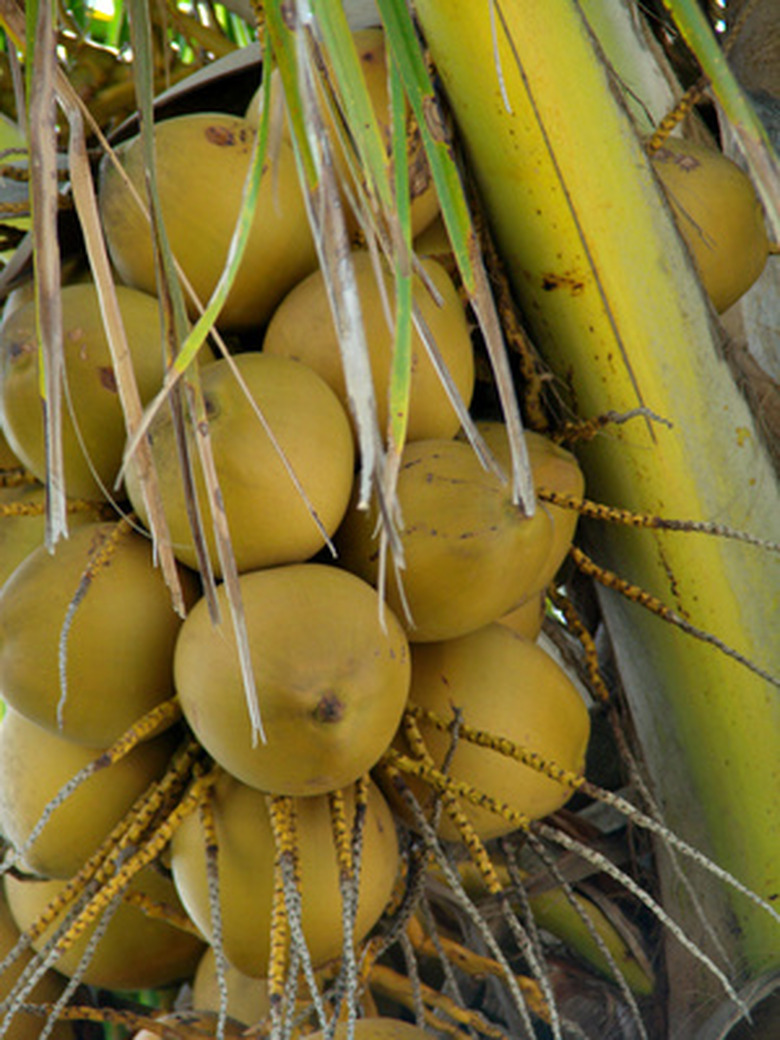How To Care For A Malayan Coconut Palm
Things Needed
- Rake
- Shovel
- Mulch
- Fertilizer
- Micro-nutrient spray
- Loppers
Malayan coconuts (Cocos nucifera) are members of the family Arecaeae and believed to be South Pacific natives. Though often referred to as dwarf or pygmy, Malayan coconut palms grow from 30 to 60 feet in height with a spread of 15 to 25 feet. Strains of Malayan coconuts are most resistant to lethal yellowing. Categorized by the color of their fruits, coconuts are red, yellow, gold or green, such as green Malayan dwarf. Malayan coconut trees are relatively low maintenance and their high tolerance to wind, drought and salt make them suitable for coastal plantings.
Step 1
Grow Malayan coconuts in the ground in USDA planting zones 10 through 11, as they are not cold-tolerant and will die in freezing temperatures. Grow the palm inside a large container in cooler regions. Bring containers inside to a protected area during bouts of cold weather.
- Malayan coconuts (Cocos nucifera) are members of the family Arecaeae and believed to be South Pacific natives.
- Grow Malayan coconuts in the ground in USDA planting zones 10 through 11, as they are not cold-tolerant and will die in freezing temperatures.
Step 2
Grow the Malayan coconut palm in an area that has full sun, where the palm will perform best. It will not tolerate the shade.
Step 3
Clear an area approximately 3 to 4 feet in diameter of all vegetation before planting the palm. Keep the area vegetation-free for the duration of the palm's life, as this will cut down on injuries to the trunk from lawn equipment and disease.
Step 4
Plant the Malayan coconut palm in native soil not amended with organic material.
Step 5
Plant the palm in a hole that is twice as wide as the palm's root ball but no deeper than the Malayan is growing inside the original container. Backfill the hole halfway with soil and firm up with your foot. Water to settle the soil before filling the planting hole completely with soil.
- Grow the Malayan coconut palm in an area that has full sun, where the palm will perform best.
- Clear an area approximately 3 to 4 feet in diameter of all vegetation before planting the palm.
Step 6
Water the newly planted palm immediately after planting, thoroughly saturating the roots. Continue to water with approximately 1 inch of water weekly, especially during the first three to four months.
Step 7
Apply a 2- to 3-inch layer of mulch around the planting site, keeping the mulch 2 to 3 inches from the trunk. Allowing the mulch to butt against the trunk causes disease and root rot.
Step 8
Fertilize 1-year-old trees every three to four months with a foliar micro-nutrient spray as well as an application of palm special granular fertilizer. Fertilize older trees every three to four months with the palm special fertilizer, per package instructions.
Step 9
Prune away the fronds that have turned brown and have no green remaining on them. Pruning fronds that still are green takes nutrients away from the palm tree and can impede its growth.
- Water the newly planted palm immediately after planting, thoroughly saturating the roots.
- Fertilize older trees every three to four months with the palm special fertilizer, per package instructions.
Tip
Malayan coconuts will produce fruit in approximately five to eight years. Harvest the coconuts in approximately 12 months when they are fully mature. For those wanting the milk, harvest the coconuts when they are approximately 7 months old. Even though the palm is drought tolerant, coconuts will benefit from regular watering. Malayan coconuts are heavy feeders, performing best when given regular feedings.
Warning
Amending the planting site with organic material will impede the palm's root growth, according to the University of Florida.
